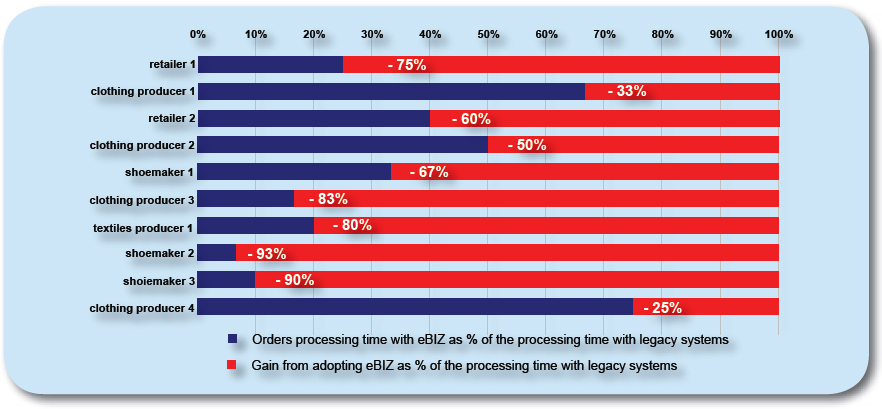|
Benefits commonly associated to the electronic documents interchange are relevant to:
- Increase in efficiency, by decreasing operating costs. These benefits can be labelled as static benefits and can be measured according to a “before and after” approach. They mainly improve the cost competitiveness of the company.
- Increase in effectiveness, by reducing lead time, response times and increase flexibility. These benefits can be labelled dynamic benefits
and enable companies to provide better services to the customer. Due to their enabling nature, the actual positive outcome will only accrue to those companies that implement coherent market strategies. They improve mostly non-price competitiveness.
- Reduction of software implementation costs. The XML based eBIZ Reference Architecture implementation has generally lower software
development costs and lower deployment costs in comparison to the existing EDI systems.
The eBIZ adoption brings benefits which may vary on their extend and rapidity based on the fashion companies’ legacy systems, and for instance:
- Fashion companies new to electronic documents exchange, the upgrade to e-Business, from communication tools like fax/ phone/ email,
generates the widest leap in terms of improvement. Benefits are large and normally gained in the short term;
- Companies formerly using legacy proprietary electronic documents exchange systems but new to an open standard system. For these type
of companies benefits are lower in the short term and express their potential as the company business network increases (new customers, new suppliers) or in the long term thanks to lower software maintenance and development costs.
The companies involved in the pilots focused mainly on the improvement of orders processing. A survey carried out on a sample of participating companies immediately after the implementation showed large gains from the
eBIZ adoption in orders processing time.

Gains in order processing time from adopting eBIZ in a sample of pilots participants
|


![[PRECEDENTE]](/moda-ml/images/but_previous.gif)
![[INDICE]](/moda-ml/images/but_up.gif)
![[SUCCESSIVA]](/moda-ml/images/but_next.gif)
![[PRINT]](/moda-ml/images/but_print.gif)
![[PRECEDENTE]](/moda-ml/images/but_previous.gif)
![[INDICE]](/moda-ml/images/but_up.gif)
![[SUCCESSIVA]](/moda-ml/images/but_next.gif)
![[PRINT]](/moda-ml/images/but_print.gif)










